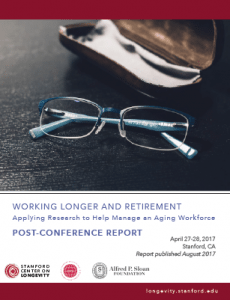Working Longer and Retirement: Applying Research to Help Manage an Aging Workforce
 With millions of Americans living longer lives compared to prior generations, it’s inevitable that many will want to work to later ages, for a number of reasons. For example, many workers may want to accumulate more retirement resources, continue their career aspirations, or stay engaged and productive.
With millions of Americans living longer lives compared to prior generations, it’s inevitable that many will want to work to later ages, for a number of reasons. For example, many workers may want to accumulate more retirement resources, continue their career aspirations, or stay engaged and productive.
However, there are a number of institutional and practical challenges if millions of older Americans want to keep working. To address these challenges, the Stanford Center on Longevity hosted the “Working Longer and Retirement Conference: Applying Research to Help Manage an Aging Workforce” on April 27-28, 2017, on the Stanford campus in Palo Alto, CA. The conference was organized and hosted by the Center and the Stanford Institute for Economic Policy Research (SIEPR), and sponsored by the Alfred P. Sloan Foundation.
The Center and SIEPR organized this conference with the goal of gathering a group of academic researchers, employers, and human resource practitioners to discuss how to apply emerging academic research conclusions to the practical challenges of managing an aging workforce.
The compendium summarizes major discussion themes of the conference, including:
- The compelling case for people to work longer
- The significant barriers for individuals who are trying to stay in the workforce and for employers who are trying to engage workers past traditional retirement ages
- Older workers have different priorities and needs
- There are many steps that various stakeholders can take to accommodate an older workforce
- Future research can help address the challenges of an aging workforce.

